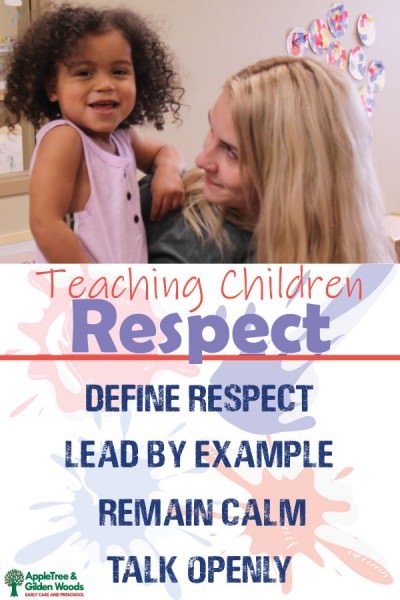- 855.520.6712
- Schedule a Tour
Respect for one another is an important value in our everyday lives. However, it is a challenge to find ways to teach this value to children. We have all heard that we must give respect to get respect and this is very true. It relates back to the golden rule, treating others as you would like to be treated.
As with anything, it is sometimes easier said than done. I am a first-time mother of a very independent and strong willed 4-year-old. Respect is our biggest struggle right now. I find my head racing in those heated moments; how do I stay calm, how do I respect the decision he is making, how can I get him to listen, why doesn’t he respect me, what am I doing wrong?
One thing I know for sure and take comfort in is the fact that I am not alone. Most children go through a defiant stage, and many parents find themselves in frustrating situations where there is a struggle for respect. During those trying moments, are the teachable moments.
Here are some tips to help teach your child about respect while also expanding your point of view on how to model respect in everyday life for them to emulate.

Define Respect: Take time to communicate with your children what respect means. Help them understand what respect looks like and how they can practice being respectful. Give them plenty of examples and positive affirmations, for example: “It’s so nice and very respectful when you listen quietly when I am talking to you. “You do a great job showing your teacher respect at school when you look her in the eyes when you talk to her.” “I know you love to play with blocks. Doesn’t it feel good when a friend invites you to play blocks, or shares their blocks with you? They’re showing you respect.”
Leading by example: Children model what they see. They take after the relationships that are in front of them every day. The way that you treat those around you; spouse, significant other, children, family members, friends, coworkers, parents, etc. in the moments when you get lost in frustration or anger, bring your awareness back to who is watching, what they are learning, and how you can model expected or desired behavior. How would you like them to react to a similar situation?
Remain Calm: The power of breath is sometimes underestimated. When respect becomes an issue, teach your children to stop and take a deep breath. “Taking a deep breath really does calm you down by triggering neurons in your brain which tell the body it is time to relax, a new study has found there are neurons which link breathing to relaxation, attention, excitement and anxiety located deep in the brainstem” This allows everyone to slow down and calm the body down, which can reroute potentially frustrating situations.
Talk Openly: Talking about who we respect and why we respect those people gives you an opportunity to bring it full circle for your child. Once they understand what respect is, they can truly start to understand how to embody that and who to respect; mom, dad, laws, teachers, friends, themselves. Take the little moments and turn them into teachable moments, “I don’t want to clean my room” can turn into a conversation about respect. Respecting your personal property, the rules, and your parents.
At AppleTree & Gilden Woods, respect is very important to our CORE Values Character Education Program. For the month of July, we bring acute awareness to how we can embody respect and make a point to work it in to our every day lives. Below is an activity that we do in our classrooms, that you can try at home with your children around the dinner table or while sharing your day:
The “Talking Stone”
Activity Materials needed:
- Medium Rock or Paint Stick (optionally can be decorated)
Often during circle time, many preschoolers want to talk at once. One way to help children learn how to take turns is to use a visual clue.
Try using a “talking stick” or “talking stone.” Hold your “stick” or “stone” while you speak and then pass it on when it’s time for another person to talk. Only the person with the talking stone or stick may speak. You can use a colorful rock or decorate your stick in a special way.
This technique helps young children learn to respect the speaker and to wait and listen. Continue with this idea and soon the children will be reminding each other.
